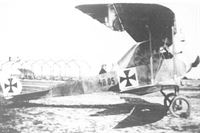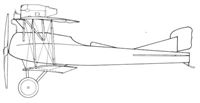
Описание
Страна: Австро-Венгрия
Год: 1915
P.Grosz, G.Haddow, P.Shiemer Austro-Hungarian Army Aircraft of World War One (Flying Machines)
Lloyd 40.04
The Lloyd 40.04 was the first of several prototypes built to investigate the veneer wing, Bier's most notable invention. A typical veneer wing consisted of five to nine ribs per wing panel, to which were attached some 10 to 16 stringers (10 mm square) spaced at even intervals around the rib profile and running the length of the wingspan. The top and bottom stringers were joined by a 2 mm plywood web running spanwise between the ribs, forming a series of box frames that imparted great strength. The outer skin was composed of 1.2 mm veneer plywood glued and nailed to the support structure. Because the inherent strength of the veneer wing eliminated the requirement for most metal fixtures and all internal wire and tube bracing, Bier reasoned that it could be assembled by unskilled workers in less time than a conventional wing. Unlike a fabric-covered wing, the veneer wing retained the airfoil shape between the ribs and could be given a glass-like finish. But the task of reducing excess weight and developing proper assembly techniques proved extremely time-consuming. In practice, the veneer wing was not as "easy to manufacture" as had been forecast. In the field minor repairs proved troublesome, and despite a varnish-coated interior, moisture condensation caused internal plywood deterioration that could not be verified by inspection.
Powered by a 160 hp Daimler engine, the 40.04 was basically a C.II fuselage fitted with veneer wing cellule. The inherent wing strength is demonstrated by the fact that the large-span wing of 14.5 meters (47ft 7in) was braced by a single pair of interplane struts. The Lloyd 40.04, completed about the time Bier filed for his wing patent (27 April 1916), was reported in the Lloyd shops for modification in July, and flight tests continued in August 1916. In Flars records the 40.04 belongs to the group of experimental aircraft (40.09 and 40.12) that served to test and develop the veneer wing for the Lloyd C.IV series 44 and C.V series 46 biplanes.
Lloyd 40.04 Specifications
Engine: 160 hp Daimler
Maximum Speed: 147 km/hr (91 mph)
Climb: 1000m (3,281 ft) in 5 min 10 sec
3000m (9,843 ft) in 25 min 12 sec
Lloyd 40.05
Before the appearance of synchronized guns, designers, in their quest for an unrestricted forward field of fire, sought solutions in aircraft of bizarre shape. The ungainly Lloyd 40.05 (Type FJ - Flugzeug Jager - aircraft hunter) was no exception. The gunner standing above the engine in a raised turret had an ideal position but one wonders how the pilot, given his limited field of view from the rear cockpit, was to keep the adversary in sight or communicate with the gunner. Perhaps the gunner was provided with some form of steering control? The 160 hp Daimler-engined 40.05 prototype, under construction in January 1916, appeared for flight tests in late spring 1916. Whereas structural information is quite complete in Lloyd records, the lack of performance data leads to the assumption that the 40.05 prototype, a private-venture undertaking, performed only the most perfunctory flight tests.
Between July and September 1916, the 40.05 was modified as a single-seat fighter. According to project drawings, it was armed with three machine guns; one in a Type II VK canister over the wing and two mounted on the lower wing outside the propeller arc. After the 40.05 fighter was demonstrated at Aspern in December 1916, Flars issued this critique: "In regard to its dimensions, the reconstructed 40.05 does not appear to be the basis for a competitive fighter. Unless good performance is achieved, further work should be stopped." In the event, development of the 40.05 fighter was discontinued and production plans for the derivative Lloyd D.I series 45 fighter shelved.
Lloyd 40.05 Specifications
Engine: 160 hp Daimler
Wing: Span Upper 11.17 m |36.65 ft)
Span Lower 10.72 m (35.17 ft)
Chord Upper 1.45 m (4.76 ft)
Chord Lower 1.45 m (4.76 ft)
Sweepback Upper 8 deg
Sweepback Lower 8 deg
Gap 1.90 m (6.23 ft)
Total Wing Area 25 sq m (269 sq ft)
General: Length 6.92 m (22.70 ft)
Height 3.10 m (10.17 ft)
Loaded Weight 962 kg (2121 lb)
Lloyd D.I Series 45
Manufacture of the Lloyd single-seat fighter, based on the 40.05 prototype, was discussed by Flars in July 1916. The design drawings were completed in September and 16 series 45 fighters, powered by the 160 hp Daimler engine, were ordered in December. Armament consisted of a single Type II VK gun canister mounted over the center-section. No mention was made of the two machine guns mounted over the lower wing as originally proposed by Lloyd. Officially the design was referred to as "series 45", but had it gone into production the designation "D.I" would have been appropriate. In February 1917, the contract was annulled to make way for the Lloyd C.V.
Описание:
- P.Grosz, G.Haddow, P.Shiemer Austro-Hungarian Army Aircraft of World War One (Flying Machines)
- E.Hauke, W.Schroeder, B.Totschinger Die Flugzeuge der k.u.k. Luftfahrtruppe und Seeflieger 1914-1918
Фотографии
-
P.Grosz, G.Haddow, P.Shiemer - Austro-Hungarian Army Aircraft of World War One /Flying Machines/
The simple elegance of the veneer wing is emphasized in this view of the Lloyd 40.04, photographed at Aspern in mid-1916.
Lloyd 40.04, Aspern. Einfliegerei, Versuchsflugzeug mit Fourniertragflächen, einstieliges Tragwerk
Lloyd 40.04, Асперн. Облет, экспериментальный одностоечный биплан, крылья имеют конструкцию Fourniertragflächen (вместо полотна использовались полосы шпона). -
P.Grosz, G.Haddow, P.Shiemer - Austro-Hungarian Army Aircraft of World War One /Flying Machines/
The Lloyd 40.04 prototype at Aspern. A distinguishing feature of the Lloyd veneer wing is the relatively few wing ribs in relation to the wingspan.
Lloyd 40.04. Rückansicht; deutlich sind die Fournierplattensegmente erkennbar
Ллойд 04/40. Вид сзади; отчетливо видны полосы шпона в конструкции крыльев (Fourniertragflächen). -
P.Grosz, G.Haddow, P.Shiemer - Austro-Hungarian Army Aircraft of World War One /Flying Machines/
Lloyd 40.05 prototype at the Aspern test center in mid-1916. The barely-visible controls (or instrumentation) in the gunner's position may indicate some form of steering control.
Lloyd 40.05. Rückansicht mit dem Beobachterstand neben den oberen Tragflächen, Fournierflügel
Lloyd 40.05. Наблюдатель рядом с верхними крыльями -
P.Grosz, G.Haddow, P.Shiemer - Austro-Hungarian Army Aircraft of World War One /Flying Machines/
The pilot’s view in the Lloyd 40.05 prototype was severely restricted by the raised gunner’s position over the engine. The “hung-on” ailerons are characteristic of the veneer wing.
-
P.Grosz, G.Haddow, P.Shiemer - Austro-Hungarian Army Aircraft of World War One /Flying Machines/
Lloyd 40.05: The fuselage windows, the fully-cowled engine, the lower-wing fuselage construction, and the aileron quadrants fail to detract the eye from the embarrassed pilot hiding behind the wing.
-
P.Grosz, G.Haddow, P.Shiemer - Austro-Hungarian Army Aircraft of World War One /Flying Machines/
Shown at the Military Aircraft Exhibition in Budapest in April 1917, the single-bay Lloyd C.IV 44.41 (ex 40.12) had more sharply-pointed wings in contrast to earlier Lloyd aircraft. In the background can be seen the tail of the second version of the Lloyd 40.05 (D.I Series 45).
Другие самолёты на фотографии: Lloyd C.II / C.III / C.IV - Австро-Венгрия - 1915
-
P.Grosz, G.Haddow, P.Shiemer - Austro-Hungarian Army Aircraft of World War One /Flying Machines/
The Lloyd D.I Series 45 fighter, taken from a design drawing dated September 1916. The airframe was modified from the Lloyd 40.05 prototype and exhibited at the Budapest Military Aircraft Exhibition in April 1917.








